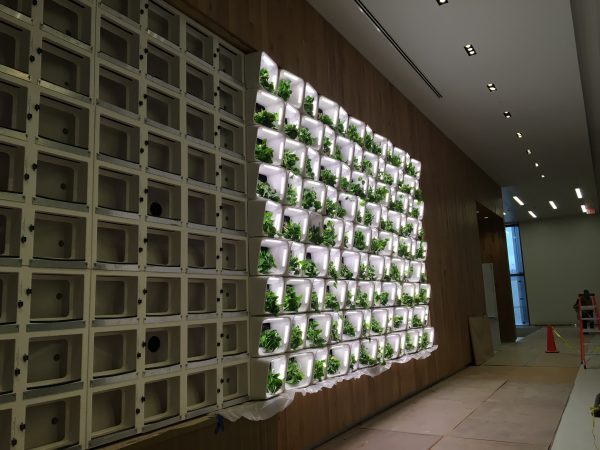Designing for indoor air quality: Talking with Jefferson Ellinger

Just as trees can improve the air quality in our communities, plants can make the air in our homes and buildings cleaner. UNC Charlotte Associate Professor of Architecture Jefferson Ellinger and his partners at Fresh Air Building Systems have been working for years to develop the AMPS (Active Modular Phytoremediation System), a “probiotic” plant wall air filtration system. As air moves through the AMPS plants’ root rhizosphere (the micro-ecosystem surrounding the root ball), microbes on the roots eat contaminants that are in the air.
The first AMPS has just been installed in the Bronx, New York, in the new Public Safety Answer Center II, and Fresh Air Building Systems has signed a consulting contract with Surface Design to incorporate the AMPS technology in the new San Francisco International Terminal 1, due to be completed in 2018. UNC Charlotte Center City will host a working model AMPS plant wall during the KEEPING WATCH on AIR project period.
Q: How did you become interested in architectural design that directly deals with issues of sustainability?
A: It evolves through just being an architect, really. Part of the mission of being an architect is to protect the health, safety, and welfare of the public. The building industry contributes something like 40 percent of the problems with the environment, in terms of energy, etc., so trying to find way to reduce the impact that architecture has was important. Building integrated systems like the AMPS wall, I thought, would be the one of the best solutions. AMPS can provide commercial/institutional buildings with dramatically improved indoor air quality and also has the potential to significantly reduce energy consumption and HVAC equipment requirements.
Q: How did you arrive at the current design for the AMPS wall?
A: Really, what the system is, is essentially the growing media for the plant and the way we are watering the plant and the way we are monitoring the plant. It’s all about designing how the air moves through the plant. What I do is to help integrate that aspect of the product into the architecture. Every installation is designed specifically for the context. What they wanted in the Bronx was a plant wall. The project we’re working on for the San Francisco airport is hung from the ceiling, so it’s going to look totally different from the Bronx installation.
Q: How do you draw air through the plant?
A: It is all connected to the HVAC system. The fans in the HVAC system produce the negative pressure to draw the air through, and we have baffles that control the rate as it draws through. The temporary module here (at UNC Charlotte Center City) has fans built into the structure, and so the fans draw the air through the plants at a local level.
Q: How many different varieties of plants have you tested?
A: We have one right now that we have fully tested. We have 12 more that we have data on and that we think will be ready in the next six months. Right now it’s the golden pothos (also known as devil’s ivy). It’s apparently the perfect house plant for people who kill house plants. It’s a super robust, hearty plant, so maintenance is actually really low on it.
Q: Explain the system it’s planted in.
A: It’s an engineered growing medium. It’s a combination of activated carbon and Growstones (made of recycled glass) and engineered clay. No mold spores will grow, which is a big concern—in nine months we’ve had zero mold spores. And there’s a drip irrigation system.
Meg Whalen is director of communications and external relations at the UNC Charlotte College of Arts + Architecture.
Meg Whalen